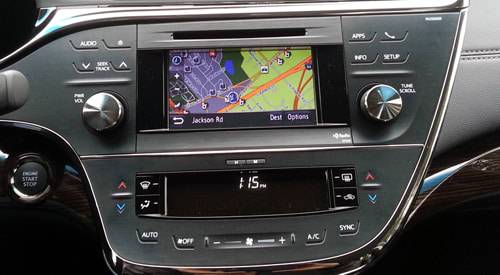2013 Toyota Avalon Does Capacitive Touch Controls Right

Touch-sensitive capacitive buttons are a purely aesthetic addition to new car interiors designed to mimic the clean appearance of a personal tablet computer. The controls, which replace traditional physical buttons, have found homes in cars ranging from compacts to luxury cars. They’re generally awful to use without physical guideposts to reference while driving and can be distracting when poorly designed.
For 2013, Toyota’s full-size Avalon received an all-new, upscale interior with capacitive buttons for climate, stereo and navigation controls. Our skepticism peaked when first reporting the Avalon’s interior used such controls considering no automaker does the capacitive trend very well. After thoroughly testing the 2013 Avalon, however, Toyota’s premium sedan surprised us with the best execution of these controls to date.
“I was 15 minutes into my drive and had adjusted the climate a few times before I looked down and realized they were capacitive touch,” says Cars.com Managing Editor David Thomas.
The Avalon’s capacitive controls succeed because the buttons respond quickly and accurately to inputs — there’s no delay, and each surface is sensitive enough to work at first touch but not so sensitive that they trigger accidentally. All of the Avalon’s buttons have large text that’s easy to read, plus the surfaces still work when wearing thick winter gloves.

Cars.com’s long-term 2011 Chevrolet Volt tester used capacitive touch surfaces for the stereo, climate and navigation controls. Drivers never fully warmed up to the control panel even after a year and more than 20,000 miles of ownership. The poorly executed surface left us mashing the controls in frustration while trying to turn on the defroster or inadvertently blasting the climate control by swiping the wrong surface on the way to an intended button. In addition, other automakers’ capacitive buttons suffer from a significant delay after the button is pressed.

There’s still no replacement for a well-designed center console with real buttons. Unfortunately, automakers don’t always give shoppers the option, like Ford does, to choose traditional control knobs. Automakers that don’t should check out the Avalon’s controls for how to do it correctly.
Related
2013 Toyota Avalon Review
Top 10 Features Drivers Don’t Need
2011 Chevy Volt: Discovering Quirks

Managing Editor Joe Bruzek’s 22 years of automotive experience doesn’t count the lifelong obsession that started as a kid admiring his dad’s 1964 Chevrolet Corvette — and continues to this day. Joe’s been an automotive journalist with Cars.com for 16 years, writing shopper-focused car reviews, news and research content. As Managing Editor, one of his favorite areas of focus is helping shoppers understand electric cars and how to determine whether going electric is right for them. In his free time, Joe maintains a love-hate relationship with his 1998 Pontiac Firebird Trans Am that he wishes would fix itself. LinkedIn: https://www.linkedin.com/in/joe-bruzek-2699b41b/
Featured stories



